Why sexing a sea turtle hatchling is important!
Boris Tezak and Itzel Sifuentes Romero
Department of Biological Sciences
Florida Atlantic University
Department of Biological Sciences
Florida Atlantic University
If you walk the beach in South Florida during a summer night, you might get the impression that sea turtles are everywhere. You might very well see hatchlings scampering to the ocean and adults nesting! That’s because we have the largest nesting population of loggerhead turtles (Caretta caretta) in the world (Figure 1), about 48,000 nests just last year! Additionally, the numbers of nesting green turtles (Chelonia mydas; ~ 28,000 nests) and leatherbacks (Dermochelys coriacea; 650 nests) have also increased over the past few years.
Although these numbers are encouraging, currently the six extant species of sea turtle found in U.S. waters are considered threatened or endangered. Together, the stresses introduced by humans have increased pollution, disease, habitat degradation and habitat destruction as risks for marine turtle survival. Humans have also hunted turtles and harvested their eggs. All of these activities have contributed to significant population declines, especially compared to historical numbers which were several orders of magnitude greater.
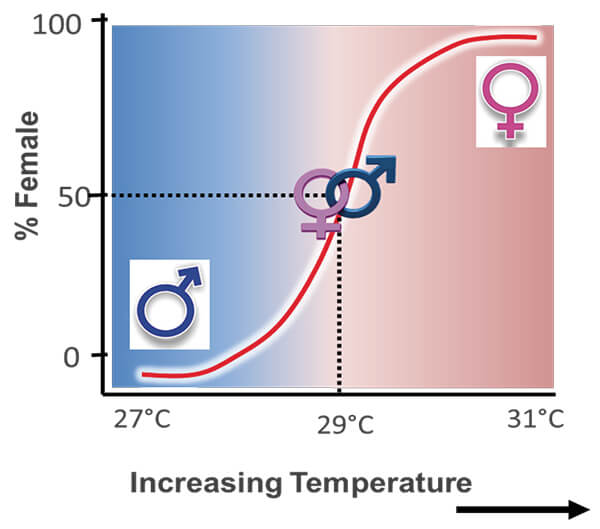 Figure 2. Sex ratio-temperature response curve. This graph shows the theoretical expected sex ratio response to incubation temperatures derived from laboratory experiments. Note that temperatures of 29°C produce a 50:50 sex ratio. Lower temperatures produce mostly males while higher temperatures produce mostly females. (Graph by J. Wyneken & B. Tezak)
Figure 2. Sex ratio-temperature response curve. This graph shows the theoretical expected sex ratio response to incubation temperatures derived from laboratory experiments. Note that temperatures of 29°C produce a 50:50 sex ratio. Lower temperatures produce mostly males while higher temperatures produce mostly females. (Graph by J. Wyneken & B. Tezak)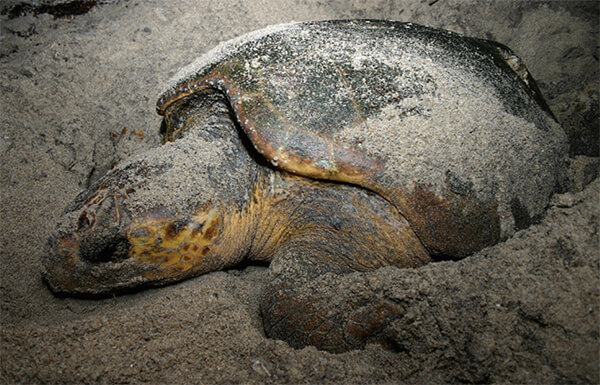 Figure 1. Loggerhead Turtle laying eggs in a Florida nesting beach (B.E. Witherington, photo)
Figure 1. Loggerhead Turtle laying eggs in a Florida nesting beach (B.E. Witherington, photo)The fragile nature of all present sea turtle populations makes it important to understand and assess the different factors that affect sea turtle populations now, and those that will remain important in the years to come. By knowing those factors we can hope to successfully promote the recovery of marine turtle populations. One particularly important factor that could influence the survival of sea turtles is climate change. Globally, we are already experiencing some of the effects of climate change with extremely hot summers, incredibly cold winters, as well as increased frequency and severity of storms. Although we can escape some of these changes through the use of technology (Air conditioning during the summer is a MUST in South Florida!), most animals are not so lucky and may soon be faced with environmental conditions that are not suitable for many key biological processes. For example, climate change may very well affect the proportion of male and female offspring produced by marine turtles and those proportions, in turn, the ability of each species to successfully reproduce. There can be no successful recovery of marine turtle populations without successful reproduction!
In sea turtles, unlike mammals (That’s us!), the sex of an individual is not determined at the moment of fertilization. This is because sea turtles lack sex chromosomes (X and Y in humans) and therefore, they don't have sex-specific genes (genes present only in a male or a female) that direct an embryo to become one or the other sex. Instead, sex in turtles is determined by the environment that the embryos experience during incubation inside the nest, and in particular by nest temperature (Figure 2).
In sea turtles, this pattern of temperature-dependent sex determination (TSD) is informally characterized by the “hot chicks, cool dudes” rule. That translates formally into the now well substantiated observation that when nest temperatures are relatively warm, most of the hatchlings will be female and when relatively cool, male. At intermediate temperatures, both sexes will be represented. But recent research at Florida Atlantic University suggests that while temperature is an important factor, it isn’t the only factor (Figure 3).
Rainfall, and its effect on moisture conditions inside the nest, also modifies sex ratios by promoting the production of proportionally more male hatchlings in the nest than predicted by temperature, alone. This effect, which is slight but none-the-less significant, was only revealed by field studies and careful measurements carried out over the past 14 years (Figures 4). Measurements of turtle sex proportions were documented from nests exposed to known conditions of temperature and humidity by actually looking inside young turtles that came from those nests. The “look inside” was done using a laparoscope to see the immature ovaries and testes. This labor-intensive technique was developed by Dr. Jeanette Wyneken (Figure 5) and until recently, was the only reliable way to determine turtle sex in juvenile marine turtles without sacrificing the animal. (Obviously, killing the turtle to find out its sex defeated the purpose of promoting the recovery of marine turtle populations!)
However, this technique has shortcomings. Hatchlings are too small for laparoscopic surgery so the turtles must be raised in captivity for at least three months, making the entire procedure a very expensive and labor intensive method for determining sex and nest sex ratios. Additionally, an expert must perform the surgery and make the identification.
Those requirements make it impractical to obtain data on a large scale, for example, to determine how many males and females are being produced from the thousands of nests deposited each year on Florida’s beaches. What is needed, instead, is a simple and relatively inexpensive procedure for estimating nest sex ratios from hatchlings, without harming the turtles.
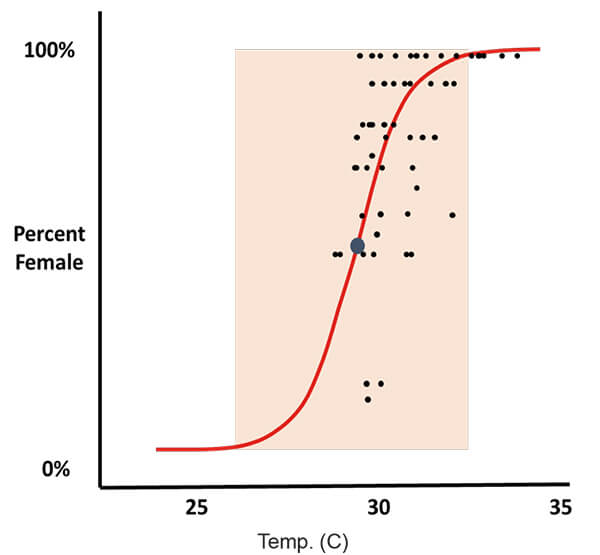 Figure 3. Expected vs. observed hatchling sex ratios of the loggerhead turtle. The red curve shows the expected sex ratio under laboratory conditions where external temperatures in incubators where the eggs develop remain constant. The black dots show the sex ratios obtained from natural loggerhead nests in south Florida, where temperature (and other conditions) fluctuates. The large blue dot shows the lab temperature (29°C) at which the hatchling sex ratio should be 50:50. Natural nests, exposed to variable temperatures that averaged 30° C (dashed box), should produce mostly females but instead, sex ratios are variable and can even result in a few nests that produce mostly males. This lack of agreement between lab and field results indicates that temperatura is not the only factor determining sex ratios (Adapted from published studies by Jeanette Wyneken and her student, Alexandra Lolavar, 2015).
Figure 3. Expected vs. observed hatchling sex ratios of the loggerhead turtle. The red curve shows the expected sex ratio under laboratory conditions where external temperatures in incubators where the eggs develop remain constant. The black dots show the sex ratios obtained from natural loggerhead nests in south Florida, where temperature (and other conditions) fluctuates. The large blue dot shows the lab temperature (29°C) at which the hatchling sex ratio should be 50:50. Natural nests, exposed to variable temperatures that averaged 30° C (dashed box), should produce mostly females but instead, sex ratios are variable and can even result in a few nests that produce mostly males. This lack of agreement between lab and field results indicates that temperatura is not the only factor determining sex ratios (Adapted from published studies by Jeanette Wyneken and her student, Alexandra Lolavar, 2015).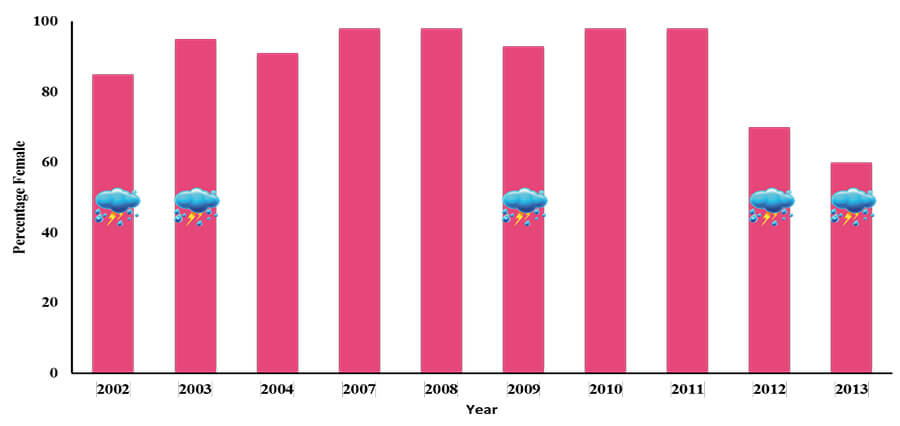 Figure 4. Loggerhead hatchling sex ratios from natural nests over many nesting seasons (adapted from Wyneken & Lolavar). Sex ratios have been female-biased since 2002 but during years with heavy rainfall (bars containing storm clouds), the sex ratio is less female-biased than during dry years. This effect occurs because during wet years, some nests produce more males than expected.
Figure 4. Loggerhead hatchling sex ratios from natural nests over many nesting seasons (adapted from Wyneken & Lolavar). Sex ratios have been female-biased since 2002 but during years with heavy rainfall (bars containing storm clouds), the sex ratio is less female-biased than during dry years. This effect occurs because during wet years, some nests produce more males than expected.Because sex determination in turtles is so closely linked to environmental conditions, the most common prediction associated with climate change is that marine turtles will be at a higher risk of extinction if warmer temperatures cause sex ratios to become even more dramatically female-biased than they already are. These concerns highlight the importance of identifying current and historical sex ratios at sea turtle nesting beaches, and using long-term sex ratio data to predict how sex ratios could change in the future. Put most simply, there may be a danger that if current trends continue, there won’t be enough males around to serve as mates for the steadily increasing numbers of marine turtle females.
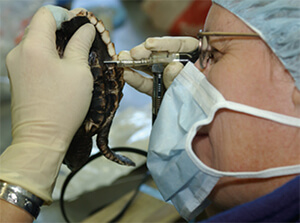
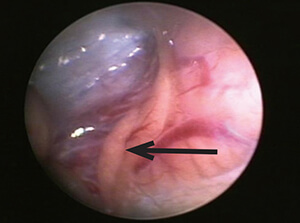
Figure 5. Left: Dr. Wyneken uses a laparoscope to peer inside a young turtle and inspect its developing gonad (ovary if female, testes if male). The examination takes only a few minutes and the turtle recovers from the surgery within 3-4 days. Right: a view of what Wyneken sees. Arrow shows the location of an ovary.
To reiterate, the sex of hatchling marine turtles cannot at the present time be determined by their external appearance; it can only be determined by methods that require sacrificing the hatchling. Attempts to estimate nest sex ratios have historically been based on nest temperatures but new studies show that temperature alone does not provide an accurate assessment. Moisture conditions must also be known but until recently, moisture has not been considered. Laparoscopy provides an accurate estimate of sex ratios for juvenile turtles but requires raising the turtles for several weeks before the surgery can be performed, an expensive and time-consuming procedure. What is needed is a reliable, non-lethal and relatively inexpensive technique to identify sex at the hatchling stage for large numbers of turtles, without harming any of them.
That’s where our work enters the scene! We are exploring a new technique to identify hatchling sex and, thus far, the results are promising. This technique takes advantage of some recent advances in molecular biology, coupled with a better understanding of the molecular signals that guide how each sex develops. According to current knowledge, temperature and moisture trigger the activity of specific genes that promote the development of each sex (Figure 6). The activity of those genes results in the production of different, sex-specific proteins that, in turn, cause an undifferentiated gonad to develop into either an ovary or a testis. This, at least, is what occurs in other reptiles such as the American alligator and the snapping turtle.
Our studies reveal that similar processes also occur in marine turtles (Figure 6). Our new method is based upon detecting these proteins from a tiny drop of hatchling blood, a sample so small that it does not impair hatchling health or affect hatchling survival.
Finding such a sex-specific marker in hatchlings would allow for large scale measurements and verification of naturally occurring sea turtle sex ratios. Our project is very timely, especially when we consider increasing nesting temperatures and the potential impacts of continued climate change on these and other turtle species with temperature-dependent sex determination. Our goal is to provide definitive information that confirms the accuracy and economic feasibility of this approach. Once that’s done, it should be possible to determine sex ratios of hatchlings from many sea turtle nests on an annual basis, and closely monitor how changes in temperature and rainfall are affecting each generation. That information will be essential for anticipating how changes in the environment are affecting marine turtle populations now, and for planning how to manage those populations in the future.
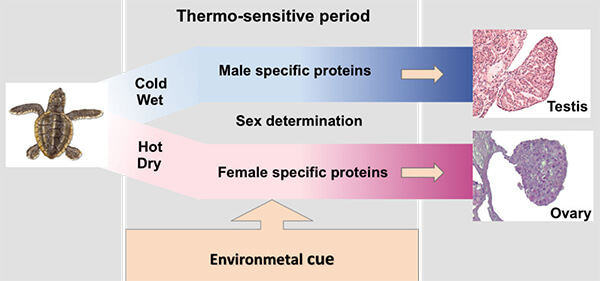
Figure 6. Schematic representation of the mechanism behind sex determination in turtles. Marine turtles take about 50 days to complete embryonic development. The middle third of that (“thermos-sensitive”) period is when environmental features (temperature, moisture) trigger development down a “maleness” or “femaleness” path. Tezak and Romero are determining whether that path can be discovered on the basis of blood proteins that are specific to each sex. (Graph based upon studies by B. Tezak and I. S. Romero)
Helping Sea Turtles Survive for 38 Years
A NON-PROFIT ORGANIZATION
State of Florida Registration Number CH-2841 | Internal Revenue Code 501 (c) (3)
Web Design & Development by Web Expressions, LLC

